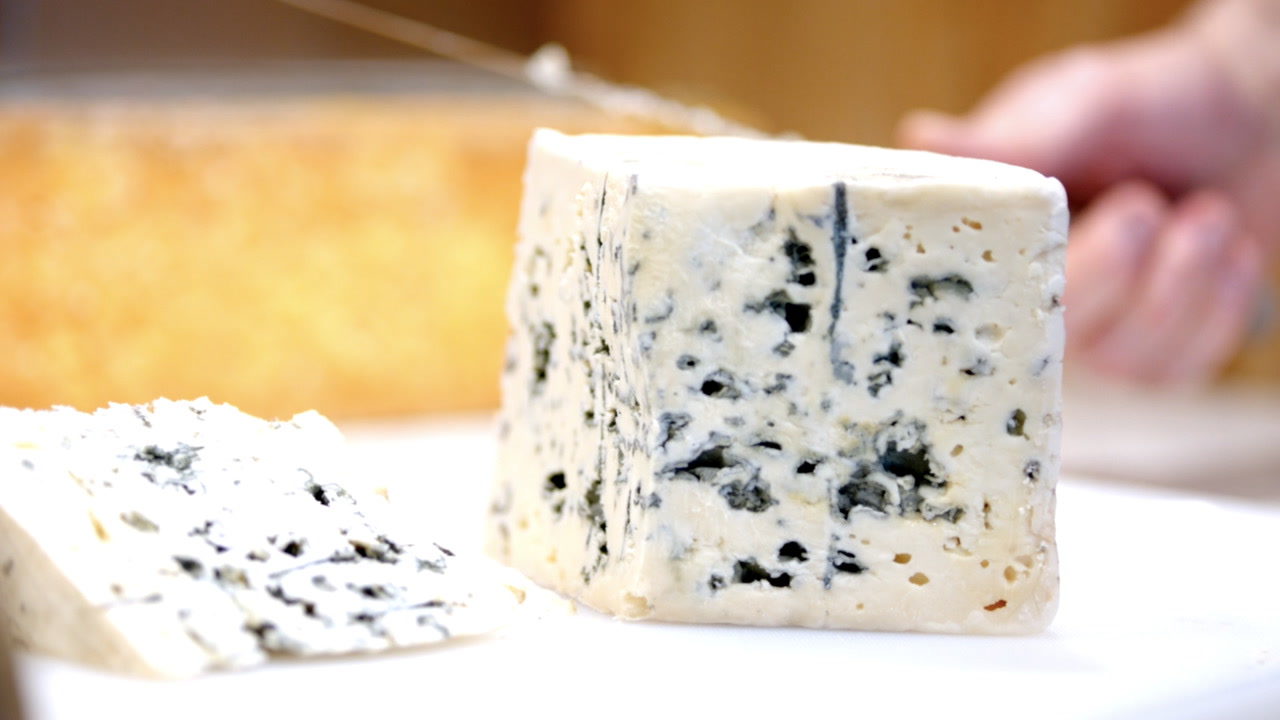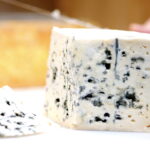Cheese has always been more than food. It is culture, history, and creativity layered into one delicious bite. Every region of the world has its own way of working with milk, and each method reveals something about the people who developed it. Among the hundreds of varieties, some stand out not just for taste, but for the way they bring together two seemingly different worlds. One of those rare creations is masgonzola, a cheese that fuses the creaminess of mascarpone with the sharp elegance of Gorgonzola Dolce.
Unlike cheeses that stand alone, masgonzola is about balance and layering. It is made by gently spreading fresh mascarpone—smooth, sweet, and buttery—over slabs of Gorgonzola Dolce, the milder and more delicate cousin of blue cheeses. Then, through careful aging, these two identities soften into one another. What emerges is not a compromise but a harmony: a cheese that is at once bold and gentle, rustic and refined.
This article will take you through the story of masgonzola, from its origins and production process to its flavors, culinary uses, and growing place in modern cuisine.
Origins of Masgonzola
The name itself is a clear clue: “Mas” for mascarpone, “gonzola” for Gorgonzola. These two Italian cheeses have long histories, but their combination into one layered product is a more modern innovation. While the exact birthplace of masgonzola is debated, most agree it grew out of northern Italy, where both mascarpone and Gorgonzola are local staples.
- Mascarpone originated in Lombardy around the late 16th or early 17th century. It is technically not a cheese in the strict sense, but a rich cream curd, set with citric or tartaric acid. With its velvety texture and mild flavor, mascarpone became the backbone of desserts like tiramisu, but it was also used in savory spreads.
- Gorgonzola, by contrast, is a true cheese with centuries of tradition. First produced near Milan in the town of the same name, Gorgonzola is one of the world’s most famous blue cheeses. Gorgonzola Dolce—the “sweet” version—has a softer texture and milder tang compared to the sharper Gorgonzola Piccante.
At some point, Italian cheesemakers asked a simple question: what would happen if they were combined? The result was masgonzola—a layered delicacy that highlights the contrast between buttery creaminess and subtle blue veins.
How Masgonzola is Made
The process of crafting masgonzola is both simple and meticulous. Unlike mass-produced cheeses, this is a product that relies on patience and balance.
- Selecting the Gorgonzola Dolce
Cheesemakers start with Gorgonzola Dolce wheels. This cheese is already soft, spreadable, and veined with delicate blue mold. Its mild flavor makes it the perfect base. - Preparing the Mascarpone
Fresh mascarpone is prepared from cream, thickened with acid. The key is freshness—mascarpone should be smooth, sweet, and spreadable. - Layering
Thick layers of mascarpone are carefully spread over slabs of Gorgonzola Dolce. The result looks almost like a cake, with alternating strata of creamy white mascarpone and marbled blue cheese. - Aging
The layered cheese is then allowed to rest. During this period, the flavors mingle. The mascarpone tames the sharpness of the Gorgonzola while absorbing some of its earthy notes. - Finishing
After maturation, masgonzola develops its signature consistency: rich, moist, and easy to spread, with no single flavor dominating the other.
Flavor Profile of Masgonzola
What makes masgonzola special is its ability to speak to two very different palates at once.
- Texture: It is soft, luscious, and creamy, almost spoonable. The mascarpone adds a custard-like quality, while the Gorgonzola brings subtle crumble.
- Flavor: Expect a delicate tang from the blue veins, balanced by the sweet, buttery mascarpone. It has a mild earthiness, but never overwhelms the palate the way stronger blue cheeses can.
- Finish: The aftertaste is long but gentle, leaving a memory of creaminess rather than sharpness.
This makes masgonzola an excellent “gateway cheese” for those who find traditional blue cheeses too strong but still want a touch of that complexity.
Culinary Uses of Masgonzola
One of the great strengths of masgonzola is its versatility. It belongs on cheese boards, in pastas, and even in desserts. Here are some ways chefs and home cooks alike use it:
On a Cheese Board
Masgonzola shines when paired with fresh fruit, honey, and nuts. Its creamy body contrasts beautifully with crisp apples, pears, or figs. A drizzle of acacia honey elevates its sweetness, while walnuts or hazelnuts add crunch.
In Pasta
Melt masgonzola into hot pasta for an instant sauce. It clings to noodles like tagliatelle or penne, delivering richness without heaviness. Often, chefs add a splash of white wine or cream to stretch the sauce.
On Pizza
Instead of mozzarella, masgonzola can be dotted over pizzas, especially those topped with prosciutto, arugula, or caramelized onions. The combination of salty, bitter, and sweet is irresistible.
In Risotto
A spoonful stirred into risotto at the end of cooking transforms the dish into something luxurious, lending depth and creaminess at once.
With Meat
It pairs well with roasted meats, especially beef or pork. A small dollop on top of a steak acts like a decadent butter.
As a Spread
Masgonzola can be spread on toasted bread or crackers, served plain or topped with roasted vegetables.
In Desserts
Surprisingly, its mascarpone layer allows masgonzola to work in certain desserts. Cheesecakes, tarts, or even a savory-sweet tiramisu variation can feature this cheese.
Pairing Masgonzola with Wine and Drinks
Like all cheeses, masgonzola begs for the right drink. Its dual character gives you options:
- White Wines: A crisp Riesling or Sauvignon Blanc cuts through the creaminess while complementing the tang.
- Red Wines: Light reds like Pinot Noir or Barbera balance without overpowering.
- Dessert Wines: Sweet wines such as Moscato d’Asti or Sauternes enhance the mascarpone’s sweetness and contrast the blue notes.
- Beer: A Belgian Tripel or wheat beer offers spice and effervescence that pair well.
- Non-Alcoholic: Sparkling water with lemon or a crisp apple cider also work beautifully.
Why Masgonzola Matters Today
In a world where food trends often chase novelty, masgonzola represents something deeper: creativity rooted in tradition. By bringing together two beloved Italian cheeses, it offers a modern twist that remains respectful of heritage.
It also reflects today’s dining culture, where people crave complexity but don’t want overwhelming intensity. Masgonzola fits neatly into this demand: refined enough for a gourmet table, yet approachable enough for casual enjoyment.
The Growing Popularity of Layered Cheeses
Masgonzola is part of a larger movement in cheesemaking where layering and blending create new flavor experiences. Cheeses combined with herbs, truffles, or other dairy products have grown popular in specialty markets. Masgonzola, however, has an edge: it layers two classics rather than reinventing from scratch.
As consumers become more adventurous, cheeses like masgonzola find a wider audience beyond Italy. Specialty shops in Europe, North America, and Asia now stock it, often recommending it as an introduction to blue cheese.
How to Buy and Store Masgonzola
If you’re lucky enough to find masgonzola at a local shop, keep a few tips in mind:
- Look for Freshness: The mascarpone should be creamy and white, not yellowed. The Gorgonzola should have fine blue veins without dryness.
- Storage: Wrap it in wax paper first, then loosely in plastic or foil. Keep it in the fridge, but take it out 30 minutes before serving for full flavor.
- Shelf Life: Because of the mascarpone, masgonzola has a shorter shelf life than hard cheeses. Consume within a week of opening.
Conclusion
Masgonzola is not just a cheese—it is a conversation between two worlds. It takes the delicate sweetness of mascarpone and the earthy tang of Gorgonzola Dolce, then fuses them into a layered delight that is both elegant and comforting.
For anyone curious about blue cheeses but hesitant to dive into the deep end, masgonzola is the perfect entry point. For seasoned cheese lovers, it offers something new yet familiar. And for chefs, it is a versatile ingredient that elevates both savory and sweet dishes.
At its heart, masgonzola reminds us why cheese endures as a cultural treasure: it is endlessly adaptable, always surprising, and deeply satisfying. The next time you’re building a cheese board or looking for a special ingredient to wow your guests, consider masgonzola. You’ll discover that some marriages—like mascarpone and Gorgonzola—are truly made in heaven.





